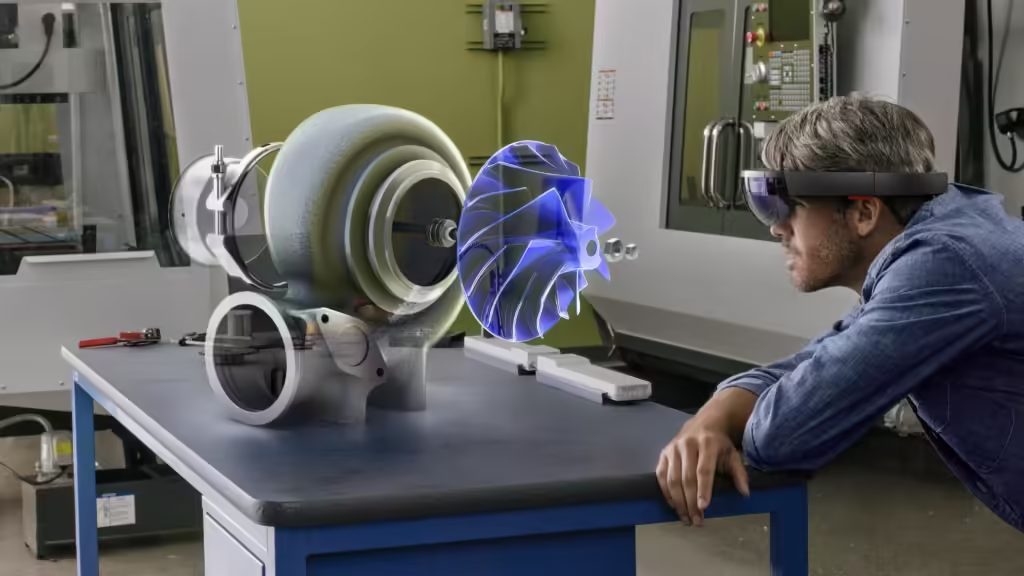The virtual world has emerged as a game-changing technology altering various industries, including supply chain management. This article discusses supply chain management in virtual worlds.

As innovators combine technology with unique thought, the metaverse’s potential grows.
The metaverse’s technology, which includes Virtual Reality (VR) and Augmented Reality (AR), combines elements of both the digital and physical worlds.
However, this virtual world is accessible via game consoles, cellphones, laptops, and other digital devices, not AR and VR.
There are other advantages to the digital economy, which allows customers to make, purchase, and exchange products.
The metaverse’s integration of entertainment, e-commerce, gaming, and social alters consumer behavior and creates new opportunities for commerce enterprises.
The metaverse in eCommerce can combine the best store experience and customer service with the convenience of shopping at home.
The multimodal capacity to integrate products, describe their attributes, reply to any questions in real-time before making a purchase, and stay at home will significantly alter consumer purchasing habits.
Consider a customer looking to buy a new car online. Instead of visiting multiple websites to view brands and models online via videos, photographs, or text, the metaverse can provide the same experience in a 3D immersive environment.
It is a world in which customers can visit digital stores, engage with store staff, and directly purchase the (digital) car of their choice.
The metaverse has the potential to revolutionize digital connections, significantly influencing consumer and corporate behaviors, processes, and structures. We already know that the human mentality exhibits the same emotional experiences and emotions in VR/AR as in real life.
Therefore, it is not unexpected that prominent corporations are building digital stores for specific lines. For example, retail clothing generates tremendous interest and attracts millions of daily users to the current metaverse platforms.
Understanding Virtual Worlds
An immersive experience in a virtual world is one in which a person perceives themselves as in a virtual location, i.e., in an environment other than what they are now experiencing.
To be realistic, it must include the sensations of sight, touch, and hearing.
The primary categories of immersive experiences in virtual worlds are as follows:
- Virtual Reality (VR)
- Augmented Reality (AR)
- Mixed Reality (MR)
Virtual Reality (VR)

Virtual Reality (VR) eliminates the need for physical interaction. Consider a computer game that requires unique eyewear and headphones.
These items allow the player, represented by a character, to become immersed in the virtual environment of this experience. The participant’s control over his avatar makes all of this realistic.
Another example is a simulator for motor vehicle driving training and airplane and helicopter piloting. When utilizing this equipment, the student feels as if he is driving a car or flying, allowing him to put his newly learned orders to the test.
Augmented Reality (AR)

Augmented Reality (AR) technology superimposes virtual content on live broadcast images of the real environment. It helps deliver more information when carrying out tasks in the actual world.
One example is to acquire advice or even test a particular product before making a purchase, such as trying on clothes in a virtual mirror. This technology can also project instructions for car repairs in front of the hood, making them easier to follow.
Mixed Reality (MR)

Mixed Reality (MR) combines Virtual and Augmented Reality (RV and RA). It can be considered an advanced form of augmented reality because the technology allows users to completely interact with virtual objects superimposed on the real world.
In the preceding scenario of repairing a car, rather than modifying and managing the visuals and information projected on the computer, it would be possible to interact with the projection itself.
Innovations of Supply Chain Management in Virtual Worlds
According to a Deloitte report, since its inception in the mid-1950s, Virtual Reality has grown significantly, no longer being considered a niche technology.
However, these breakthroughs, which encourage equipment improvement and the synchronization of human and virtual operations, have yet to reach operational maturity for large-scale adoption due to challenges associated with a more extensive application for industries and consumers.
In the case of VR, we may highlight a few applications: for example, in tracking products within stocks, glasses that use “inside-out” technology (with cameras and sensors linked to the device itself) can identify the location and orientation of the surrounding environment with high precision.
In this way, the employee who utilizes this gadget can work in the stockroom and even transfer things under the control of robots without physically being present at the warehouse (see video).
There are still computational power, affordability, security, and user perception limitations. However, companies developing more complex hardware and software significantly mitigate these challenges.
More specifically, here are some advantages of Virtual worlds in Supply chain management;
- VR and AR can help visualize complex data and reduce operational risk
- Improved training efficiency
- Effective collaboration through all levels of the supply chain management
- Manufacturing
- Shorter product lifecycles
- Warehouse operations
VR and AR can help visualize complex data and reduce operational risks
They can be used with other technologies to digitize information and prevent technical difficulties (e.g., product loss) during supply chain management.
Also, while adopting 3D technology, the organization increasingly depends on data (of various sorts and levels of complexity) to organize its operations and processes.
For example, when AR technology is tested in inventories, it becomes easier to acquire information about the location of a specific product, hence streamlining the search.
Also, using printed checklists for the specified materials is avoided, resulting in better stock control.
Improved Training Efficiency
Virtual and augmented reality provides:
- Practical tools for teaching best practices in decision-making.
- Simulation of real-world scenarios.
- Low-risk learning procedures.
In addition, real-time shared visualization and engagement via avatars and simulations provide insight into supply chain management optimization.
Implementing training imitates high-risk scenarios, allowing teams to identify, prioritize, and analyze factors, lowering task risks in the actual world.
Effective Collaboration Throughout all Levels of the Supply Chain Management
The metaverse can increase collaboration across all Supply Chain management tiers, both within and outside.
Increased connectivity provides a direct collaborative approach with suppliers to save manufacturing costs while simplifying and accelerating the value chain synchronization.
This connectivity will make the entire supply chain management accessible and responsive, allowing vendors and buyers to negotiate costs more clearly and efficiently.
With broad collaboration and more in-depth production-optimized methods, co-managed margins for production faults will result in higher-quality products and services while lowering customer return rates.
Companies can expand their capabilities, cutting quality control costs and the requirement to visit vendor sites for inspection and approval.
Supply Chain Management Transparency
Even international supply chain management professionals struggle to grasp global supply networks.
Currently, stakeholders, employees, investors, and customers want greater information about where raw materials are obtained, as well as who and where components are created and finished.
They seek transparency regarding the environmental and collateral impact of the supply chain management with whom they do business.
The metaverse will increase supply chain management transparency by displaying 3D pictures of how producers build, deliver, and promote their products. Interested parties get more visibility into:
Factors to consider include lead times, freight costs, transit time, and potential delays.
This transparency and visibility will increase Supply chain management confidence, trust, and efficiency.
Manufacturing
The metaverse will make 3D visualization and virtual tools more accessible to clients, increasing accountability and transparency. This will boost creativity and accelerate mass customization options (i.e., personalized things).
It will also make it easier to digitally copy products, allowing manufacturing processes and companies to allocate resources across the Supply Chain management better and operate alternative production scenarios.
This is anticipated to reduce disruption to physical manufacturing facilities, lower downtime, and promote the adoption of alternatives and rapid changeovers in the plant.
Also, it will have a far-reaching impact on meeting customer demands for personalized items, allowing them to be produced cost-effectively in conventional facilities meant for bulk manufacturing.
Shorter Product Lifecycles
The metaverse is a beautiful place to collaborate and share ideas. It will be simple for internal and external business shareholders to collaborate on new product blueprints, share these ideas with manufacturers in the same setting, and receive immediate feedback.
This will shorten the product lifetime for new goods while accelerating the creation of practical designs, allowing for faster, more responsive, and intelligent planning.
Warehouse Operations
The metaverse’s boundless collaboration opportunities mean that every participant, from workers to logistics teams, can consider sustainability and Environmental, Social, and Governance (ESG) issues using intelligent planning tools.
Warehouse planning can be enhanced, experienced, and simulated in the metaverse before the physical form is constructed, saving time and money from concept to reality.
This will result in better, more efficient warehouse designs and pleasant work environments.
When municipal governments and local organizations adopt meta technologies, they can evaluate and support new tactics and propositions in the metaverse before replicating a final version in their files for accountability and ongoing learning.
The metaverse will provide a practical setting where strategic operator training can occur without affecting normal operations.
Review the warehouse flow before committing major CapEx dollars and outline any adjustments.
As the number of SKUs increases, further benefits will arise from improved space use via active space modeling and increased position and shelving optimization.
Optimization and slotting are vital, given the trend toward reduced and even micro-fulfillment centers, where storage space is most precious.
Challenges in Supply Chain Management in AR and VR
Supply chain management in virtual worlds has various challenges, some of which include:
- Digital asset tracking
- Scalability
- Regulation and compliance
- Cybersecurity risks
- Interoperability
- Customer expectation management
Digital Asset Tracking
Unlike tangible commodities, digital assets can be reproduced, altered, or traded in ways that are difficult to track. Innovative tracking mechanisms like blockchain technology are required to ensure the security and authenticity of virtual products.
Scalability
Because virtual worlds can expand rapidly, supply systems must scale swiftly to meet demand. This can strain server capacity, digital infrastructure, and inventory management in virtual settings.
Regulation and Compliance
The regulations governing virtual goods and services are frequently vague or inconsistent and vary by country. Companies must navigate the changing legal landscape.
Cybersecurity risks
Virtual supply chains are susceptible to hacking, fraud, and other cyber attacks, which can interrupt operations and result in considerable losses.
Interoperability
Virtual worlds frequently use several platforms, technologies, and currencies. Providing seamless integration across numerous virtual environments can be difficult and expensive.
Customer Expectation Management
Customers in virtual settings demand rapid gratification and excellent service. Ensuring that virtual items are delivered in real-time might be logistically challenging.
These variables complicate the technological and operational aspects of virtual supply chain management.
Conclusion
The metaverse is still in its early phases of development. Several edge technologies will emerge and evolve in the coming years, resulting in an explosion of new ideas and approaches (but only if they improve customer and user experiences).
The apparent capabilities of the virtual worlds provide enormous benefits and applications.
Technologies such as the metaverse will be at the heart of senior Supply Chain management choices, allowing for new planning approaches, expedited virtual experimentation, and faster time to market for future items.
